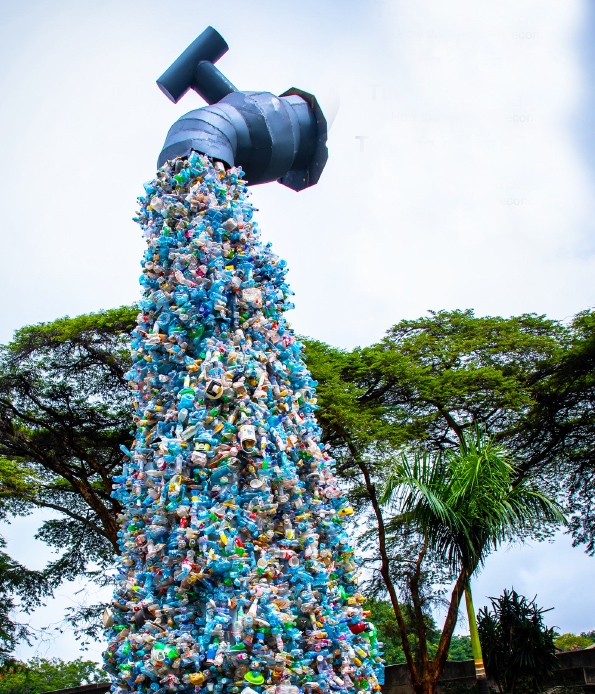New Delhi, May 28 (IANS) What do the deepest point in the ocean and the highest mountain peak have in common? The plastic pollution.
To drastically reduce plastic pollution by 2040 by reducing, recycling and introducing the use of plastic alternatives, the world is coming together in Paris for a second round of negotiations on a legally binding instrument to end plastic pollution, aka the UN plastics treaty, including in the marine environment, from Monday.
Environment Minister Bhupender Yadav, who has arrived in Paris, said India would be putting forth its experiences and lessons in tackling the plastic menace and push for recycling as “a means to spur a circular economy”.
According to this month’s report by the UN Environment Programme (UNEP), plastic pollution could reduce by 80 per cent by 2040 if countries and companies make deep policy and market shifts using existing technologies.
Addressing plastic pollution requires a dramatic transformation of the entire life cycle of plastics; from production and consumption to waste management.
In recognition of the impacts of plastic emissions to both human health and the environment, in March 2022 the world welcomed the historic resolution adopted by the UN Environment Assembly (UNEA) to “End plastic pollution: Towards an international legally binding instrument.”
Backed by science, the summit will see participation from governments, international organizations, business, civil society, and scientists who will gather at the second session of the Intergovernmental Negotiating Committee to develop an international legally binding instrument on plastic pollution.
The UNEP report, “Turning off the Tap: How the world can end plastic pollution and create a circular economy”, is a solutions-focused analysis of concrete practices, market shifts, and policies that can inform government thinking and business action.
“The way we produce, use and dispose of plastics is polluting ecosystems, creating risks for human health and destabilizing the climate,” said Inger Andersen, UNEP Executive Director. “This UNEP report lays out a roadmap to dramatically reduce these risks through adopting a circular approach that keeps plastics out of ecosystems, out of our bodies and in the economy. If we follow this roadmap, including in negotiations on the plastic pollution deal, we can deliver major economic, social and environmental wins.”
Ahead of negotiations for the global plastics treaty, Japan is one of the newest members of the High Ambition Coalition, a group of 56 countries which Norway chairs.
The coalition has decided they will negotiate demanding a complete elimination of plastic pollution by 2040, while the European Union will urge a legally binding treaty for the total elimination of plastic pollution.
Australia is pushing for it to be legally binding and include strong targets. Tanya Plibersek, Australian Minister for the Environment and Water, says “it is also important that Australia makes sure the voices of other countries in our region are heard.
The full participation of the US for galvanizing global action on plastic pollution is also crucial.
“I want to see a plastic-free Pacific in our lifetime — if we’re going to achieve that, we have to act now.”
What does the international legally binding instrument on plastic pollution, including in the marine environment) (INC-2) means?
The instrument will need to set definitions of plastic, meaning member states will agree on obligations, control measures and voluntary approaches that address the full life cycle of plastics.
According to the UNEP, under a business-as-usual scenario and in the absence of necessary interventions, the amount of plastic waste entering aquatic ecosystems could nearly triple from some 9-14 million tonnes per year in 2016 to a projected 23-37 million tons per year by 2040.
To slash plastic pollution by 80 per cent globally by 2040, the UNEP latest report suggests first eliminating problematic and unnecessary plastics to reduce the size of the problem. Subsequently, the report calls for three market shifts — reuse, recycle and reorient and diversify products.
Reuse: Promoting reuse options, including refillable bottles, bulk dispensers, deposit-return-schemes, packaging take-back schemes, etc., can reduce 30 per cent of plastic pollution by 2040.
To realise its potential, governments must help build a stronger business case for reusables.
Recycle: Reducing plastic pollution by an additional 20 per cent by 2040 can be achieved if recycling becomes a more stable and profitable venture. Removing fossil fuels subsidies, enforcing design guidelines to enhance recyclability, and other measures would increase the share of economically recyclable plastics from 21 to 50 per cent.
Reorient and diversify: Careful replacement of products such as plastic wrappers, sachets and takeaway items with products made from alternative materials (such as paper or compostable materials) can deliver an additional 17 per cent decrease in plastic pollution.
“Plastics may be a lifeboat, for the moment. But it’s a lifeboat that will be swamped in a wave of change once this agreement is in place. Don’t jump ship. Instead, steer it in another direction and let the wave of change carry you towards a future free of plastic pollution and fossil fuels,” remarked UNEP boss Inger Andersen while speaking at the US Department of State and the US Department of Agriculture at the close of an event on May 26 to galvanise global action on plastic pollution.
(Vishal Gulati can be contacted at vishal.g@ians.in)

